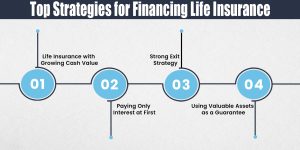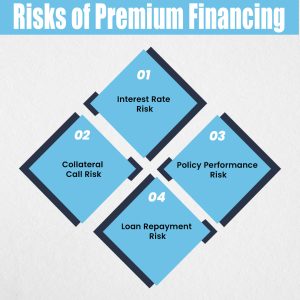Protect Your Wealth with Premium Financing Life Insurance
Last Updated on: June 18th, 2025
Reviewed by Dylan
- Licensed Agent
- - @InsureGuardian
What if we tell you that you can get a one large life insurance policy without paying all the money upfront yourself. This sounds interesting to you, right? That’s exactly what premium financing life insurance helps you do. Premium financing life insurance is a smart way for wealthy individuals to protect their family, grow their wealth, and keep more cash in their pocket. There is no need for you to pay your own money to pay the big insurance premiums. Instead, you can borrow the money from a bank or a lender. This gives you full life insurance coverage while your own money stays free with you to use for other things, like you can able to invest and grow your business. It’s like using someone else’s money to secure your future. Let’s take a closer look at this life insurance policy and also how this type of life insurance works and why many people are using it to build and protect their wealth.
Table of Contents
ToggleBasic Understanding of Premium Financing Life Insurance
Premium financing life insurance is a way to pay for life insurance without paying it all by yourself. Instead of using your own money, you can borrow money from the bank or a lender to pay the insurance premiums. Over time, the loan amount is paid back using money from the life insurance policy, your estate, or the death benefit your family receives. This will help you to keep your own money free for investing, saving, or running your business, while still getting full life insurance coverage.
Mostly wealthy people use this policy who want life insurance but don’t want to sell their other assets to pay for it. It’s also helpful for estate planning and passing a business on to the next owner.
How Financing a Life Insurance Policy Works
When someone is financing a life insurance policy, basically, they borrow the money from a bank or lender to pay the premiums. They are not using their own money to pay for it.
And in return, they have to agree to take on some of the important responsibilities to keep the loan in good standing, and also, they have to make sure that the policy stays active. These responsibilities include:
- The person who is taking the loan has to pay the interest on the loan each year
- They also have to give something valuable to a lender as a promise.
- They also have to pay back the loan later, usually with money from the insurance payout or your estate.
This way, they can keep their own money for other needs while still having life insurance and letting the policy’s value grow over time.
Life Insurance Financing: Step-by-Step Example
Let’s take a look at the example so you will better understand life insurance financing.
Sarah is 60 years old and she has built a successful real estate business. She wants to buy a $5 million life insurance policy to help with estate planning and leave a legacy for her children. The yearly premium is $150,000, but Sarah doesn’t want to use her cash to pay for it.
How Much Does Life Isurance Cost?
But for this, she works with a bank that agrees to lend her the money for the premiums.
Here’s how the arrangement with the bank works:
- The bank pays the $150,000 premium every year
- Sarah has to pay the bank interest of about 5% each year on the loan
- She uses one of her properties as a guarantee for the loan. This means that if she can’t repay it, the bank can claim the property to cover the money owed.
- When she passes away, the loan will be repaid using part of the life insurance payout
This way, Sarah keeps her money in her business, gets the life insurance she wants, and still makes sure her family is taken care of in the future.
Top Strategies for Financing Life Insurance
The best way to finance life insurance depends on many things, like your money goals, age, health, and how big of your estate. But usually, good strategies include:
1. Life Insurance with Growing Cash Value
There are some policies, like Indexed Universal Life (IUL) or Whole Life. These policies are popular because the money that is saved inside the policy grows slowly but steadily over time, and this will make it easier to plan for the future.
2. Paying Only Interest at First
This means you only have to pay the loan’s interest for some time, so you don’t spend much of your own money while the policy’s value increases.
3. Strong Exit Strategy
The most important thing is that you have to know how you will pay back the loan, no matter if it’s from the policy’s cash value, your estate, or other sources.
4. Using Valuable Assets as a Guarantee
Using things like stocks or other valuable items as a promise that will help the lender feel safe that the loan is secure, and this will make sure that you get better loan terms and keep the loan easier to manage.

Top Life Insurance Premium Financing Companies
Here are some leading life insurance premium financing companies that are experts in helping people with life insurance premium financing:
- Ash Brokerage
- National Financial Partners (NFP)
- Pacific Life
- Wintrust Life Finance
- First Republic Bank (now JPMorgan Chase)
Difference Between Policy Loan and Premium Financing
Both of the insurance policies involve borrowing money connected to the life insurance, but it’s very important to know the difference between policy loans and premium financing. Below, we have provided a chart that clearly shows the differences between policy loans and premium financing, making it easier for you to understand how each option works.
| Feature | Policy Loan | Premium Financing |
| Source of Funds | Borrowed from the policy’s cash value | Borrowed from a third-party lender |
| Collateral | The policy itself | External collateral is often required |
| Use of Funds | Discretionary | Specifically used for paying premiums |
| Repayment | Optional, but unpaid loans reduce DB | Mandatory repayment, typically structured |
A policy loan is done within your life insurance, and it is usually simple. On the other hand, Premium financing uses money from outside lenders, and it is mainly for big life insurance plans or estate planning.
Who Can Use Premium Financing?
You might be thinking who should consider the premium financing. This is a fair question, because premium financing is not for everyone. Let’s explore who should consider premium financing and why it might be the right fit for certain individuals.
- High-net-worth individuals
This is the best option for wealthy people who have a lot of assets (like property or investments) but not a lot of cash on hand.
- Business owners
Those who need big life insurance policies to protect their company or business partners.
- Estate planners
Families planning for the future who want to pay estate taxes without having to sell their property, business, or other valuable assets.
- Philanthropic individuals
People who want to give large donations to charity through life insurance.
Premium financing is not a good choice for people who don’t have enough assets to back the loan or don’t have a clear plan for paying it back.
Risks of Premium Financing
Premium financing for life insurance can be very helpful, but it also has risks. It’s important to know these risks before deciding to use it.
1. Interest Rate Risk
The loan interest rates can change over time. If the rates go up, the cost of borrowing money to pay life insurance premiums automatically increases. This means you will end up paying much more than you originally planned.
2. Collateral Call Risk
If the value of the assets you used as collateral drops, the lender may ask you to provide more collateral. This means you might have to come up with extra money or assets to keep the loan in good standing.
3. Policy Performance Risk
Some life insurance policies rely on investment returns to build cash value. If these returns are lower than expected, you might have to add extra money to keep the policy active or the financing plan working properly.
4. Loan Repayment Risk
If you can not repay the loan on time, your life insurance policy might lapse, or the death benefit could be reduced. This can cause financial problems for your family or it can affect your estate planning goals.

FAQs
1. What are the risks of life insurance premium financing?
The major risks include rising interest rates, underperformance of the policy’s cash value, collateral calls, and the inability to repay the loan. It’s a strategy that requires ongoing monitoring and strong financial health.
2. Is premium financing a good idea?
It can be, for high-net-worth individuals with strong credit, sufficient collateral, and a clear repayment plan. It’s best used in estate or business succession planning with the help of advisors.
3. Can premium financing be used with any life insurance policy?
Not all policies qualify. Typically, only permanent policies like Whole Life or Indexed Universal Life (IUL) are used, due to their cash value growth potential.
4. How do I choose the right premium financing company?
Look for a company with a strong reputation, favorable loan terms, and experience in life insurance finance. Independent brokers can also help match you with the best providers.
Conclusion
Premium financing life insurance is a smart way for wealthy individuals who want to get large life insurance coverage without using all their cash upfront. They keep their funds free for other investments or business needs, and they borrow money to pay premiums.
This way of paying for life insurance can help you to keep your family safe, pay estate taxes, and support charity. But it also has some risks, like higher interest costs, needing to add more collateral, or trouble paying back the loan. That’s why it’s important to get help from experts who understand these risks. When done the right way, premium financing can be a strong tool to protect your money and help it grow.
Are you ready to protect your wealth and secure your family’s future with premium financing life insurance? Contact Insure Guardian today for expert guidance tailored to your unique needs. Our experienced advisors will help you navigate the risks, find the best financing options, and create a smart plan that works for you. Don’t wait, take control of your financial legacy now! Visit our site or call us to get started.

Expert Life Insurance Agent and health insurance agent
Dylan is your go-to guy for life and health insurance at InsureGuardian. He’s helped over 2,500 clients just like you figure out the best insurance plans for their needs. Before joining us, Dylan was sharing his expertise on TV with Global News and making a difference with various charities focused on health. He’s not just about selling insurance; he’s passionate about making sure you’re covered for whatever life throws your way.
